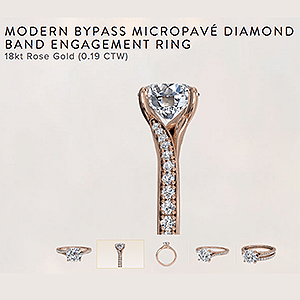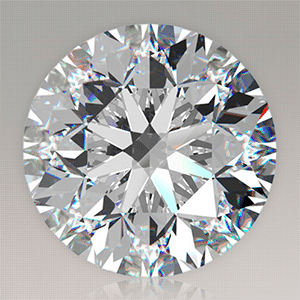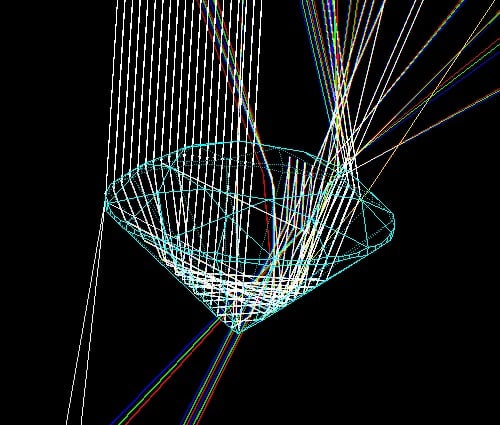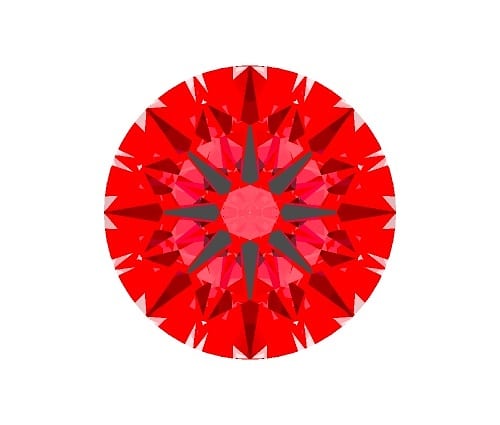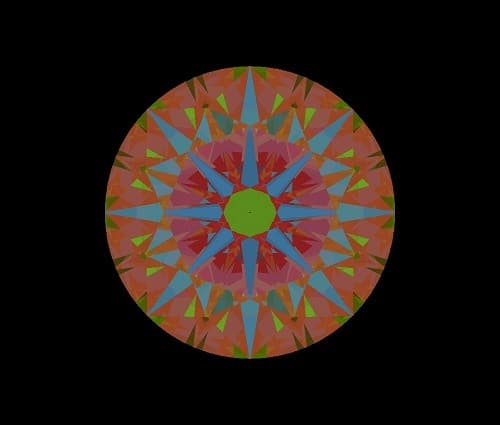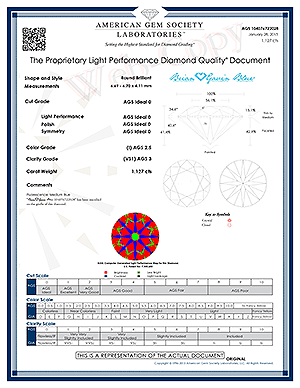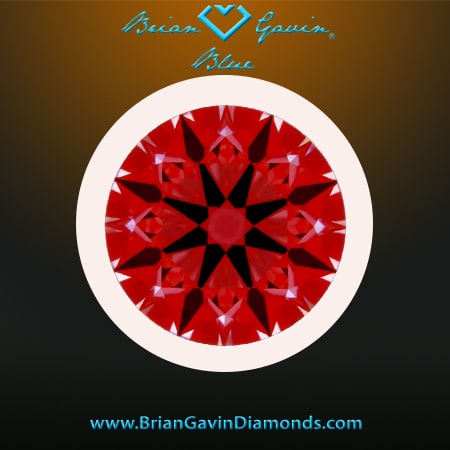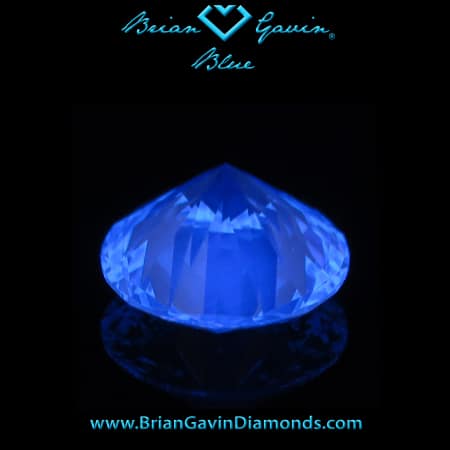“My girlfriend really likes the design of the Ritani Modern Bypass diamond engagement ring in 18k rose gold. However, there are mixed reviews about the ring, and their diamonds."
"We’re wondering whether you’ve had any experience with this setting, and what your opinion is of this Ritani diamond which seems pretty close to the specs of a 60/60 ideal cut diamond.”
“It scored 1.6 Excellent TIC on the Holloway Cut Advisor, which is a bit confusing to me since it only gave it Very Good for Fire and Scintillation."
We were originally looking at Brian Gavin. However, they don’t have a setting similar to this. We’re a bit concerned about ordering a custom engagement ring sight unseen.”
Ritani Modern Bypass Ring Review:
As a matter of fact, several of my clients have ordered the Ritani modern bypass ring and absolutely love it! However quite a few of them have also told me that they love the design of the ring.
They also said that it feels a bit lighter than they expected, and that the diamonds seem a bit smaller than they thought they would be. However, this doesn’t surprise me because I have almost 30 years of experience buying diamonds and jewelry.
In that case, I have an idea of what it means when a ring weighs 2.05 grams. I also know what to expect when I see all of those tiny diamonds set in the band of the ring. After all, Ritani clearly states that the combined total diamond weight is only 0.19 carats.
Those little diamonds really are tiny folks! But so are the diamonds in most commercially made diamond engagement rings. They are intended to be accent diamonds, and tend to be smaller in size to keep costs down.
That makes sense since everybody is concerned about cost. However, there is also a large segment of the populace who are looking for something better.
Such as an engagement ring that feels more substantial. Like a ring that incorporates accent diamonds that are larger in size, and better in quality.
People like us might be a bit concerned about ordering a custom diamond engagement ring online, sight unseen. At least initially, but most people get used to the idea when more information is available.
Ritani French Halo Setting Review:
This scenario reminds me of another client named Anita. Her fiancé ordered the Ritani French Set Halo setting with a one carat round diamond for in-store preview.
She wasn’t quite satisfied with the quality of the setting, nor the sparkle factor of the diamond. Anita did like the setting concept of the setting. However, she wanted it to feel a bit more sturdy.
She also wanted the ring to have a higher carat weight of accent diamonds. Most importantly, Anita wanted the center stone to sparkle like crazy. In other words, she desired the broad-spectrum sparkle she’d read about on our site.
Brian Gavin Custom Halo Setting:
The only option was to get in touch with the custom jewelry design division of Brian Gavin, and commission them to design a custom setting for Anita.
The end result is the Anita Halo by Brian Gavin, which is aptly named after my client. Consequently, it's customary at BGD to name custom settings after the person who commissioned the design.
The Anita setting by Brian Gavin features a combined total diamond weight of 0.53 carats. That is significantly more than the 0.21 carats t.w. featured in the French halo setting by Ritani.
At least the version that Anita initially ordered. Now here is a 0.45 carat t.w. version of the Ritani French halo setting available. Obviously, the two ring designs by Ritani and Brian Gavin do not look exactly the same.
Each jewelry designer must incorporate their own sense of design into every custom ring they create. In that case, these halo settings share similar traits and yet, are completely different.
The 60/60 Ideal Cut Diamond Myth:
Old-timers in the diamond industry like to ramble on about the mythical 60/60 ideal cut diamond. From my perspective, it might as well be a unicorn.
According to “them” the diamonds' proportions somehow magically fall into place if the total depth and table diameter are sixty percent. That is absurd to anybody with any kind of real diamond grading experience.
The reality is that the total depth of 60% can be divided up between the crown height and pavilion depth in many ways. In other words, the crown and pavilion sections might be shallow or deep. The girdle thickness also factors into the equation if we're being technical.
Nevertheless, when I was a young pup just getting started in the diamond industry back in October of 1985, yes, it really has been that long… bummer! The “logic” presented by the diamonds wholesalers who I was working at the time seemed to make a lot of sense.
But that theory fell apart when we bought a Sarin DiamCalc computerized proportions analysis system in the mid-1990s. Then I could see what a wide variance of proportions the famous 60/60 ideal cut classification encompassed.
Ritani Diamond Review, GIA Excellent 2165258209:
The one thing that this 1.16 carat, H-color, VS-2 clarity, GIA Excellent cut diamond from Ritani has going for it is the 40.8 degree pavilion angle.That should produce a high volume of light return.
Simultaneously, the 34.5 degree crown angle should produce a virtual balance of brilliance and dispersion. However the 59% table diameter is going to look kind of large by my standards.
My guess is that this diamond will pale by comparison to something like this: 1.127 carat, I-color, VS-1 clarity, Brian Gavin Signature round diamond.
We’ll get to that diamond in a moment. The details page for this Ritani diamond features the stock image of a diamond that is pictured to the left. Therefore we don’t even have a standard diamond clarity photograph.
In that case, we can't determine how evenly light is reflecting throughout the diamond. Nor can we judge the degree of static contrast the diamond exhibits.
Of course, you can always use the link provided to order the diamond. Then schedule an appointment with their virtual gemologist to discuss the details.
Mathematical Ray Tracing Results:
I’ll be straight up and tell you that I don’t have high hopes for this diamond. In other words, it's not likely to meet our selection standards.
Especially once the clarity photograph, and reflector scope images are provided. That's because the Diam Calc mathematical ray-tracing results aren't promising.
We use Diam Calc to estimate the light performance of diamonds when ASET and Ideal Scope images aren't available.
Now, when I say that the Diam Calc results aren't good, they're not too bad either. Meaning that it’s not on par with what I’d expect from an ideal cut diamond. At least not one with the proportions we recommend in the One Minute Diamond Buying Guide.
Now the thing to understand about mathematical ray-tracing programs like DiamCalc, is that in this particular instance where we’re not uploading the results of an actual computerized proportions analysis such as a Sarin scan into the program.
We’re going to get results that are less precise; because the GIA rounds off the measurements for the proportions of the diamond on their diamond grading reports, so we’re not able to take the high and low measurements into account which the average measurements stated are based upon, nor do we have all the measurements of the diamond.
Diam Calc Ideal Scope Rendering:
That means that the program assumes a kind of “perfect diamond cut scenario” based on the measurements entered for the basic framework of the diamond.
For example, the outside diameter and depth measurements, the table diameter, the crown angle, pavilion angle, and so on. Thus, the images tend to represent a “best-case scenario.”
In my experience the actual ideal scope image will not look this good. Consequently, this one indicates that we should expect to see a bit of light leakage beneath the table facet. However this 1.16 carat, H-color, VS-2 clarity, Ritani diamond is still a good option.
ASET Rendering by Diam Calc:
Assuming that you’re simply looking for a GIA Excellent cut diamond that is going to blow away the type of diamonds you’re likely to find in the average retail jewelry store.
This diamond is basically in the range of the Top 2% of the annual production of round brilliant cut diamonds. Things could be better, things could be worse, it’s better than most of the diamonds that your friends are likely to be wearing.
Ultimately it comes down to what you personally find acceptable in terms of diamond performance. By the way, notice that the pattern present in the table facet is reversed in this ASET image…
The computer-generated estimation of what this specific Ritani diamond might look like through an ASET Scope. It also indicates that the diamond is probably leaking light under the table facet.
It would be interesting to see how this diamond appears in actual reflector scope images, please forward them to me if you get your hands on them.
Brian Gavin Signature Diamond Review, AGS 104076722028:
One of the nice things about Brian Gavin Signature diamonds like this 1.127 carat, I-color, VS-1 clarity, Brian Gavin Blue Signature diamond, is that we don’t have to venture to guess about the degree of optical symmetry.
That's because every Brian Gavin Signature round diamond is submitted to the American Gem Society Laboratory (AGSL) to be graded on their proprietary Light Performance grading platform.
It relies upon Angular Spectrum Evaluation Technology (ASET) to measure the brightness of the diamonds. That provides us with a visual representation of how evenly light is being distributed throughout the diamond.
You can learn more about what the different colors of an ASET image mean by reading the article referenced via that link, but suffice to say that this diamond is going to be like a mini-mag light on her finger! You’d better buy shades!
Actual Ideal Scope Image:
Just look at how consistent the distribution of red is throughout the actual Ideal Scope image that Brian Gavin provides on the diamond details page for this Brian Gavin Blue Signature diamond.
This ideal scope image indicates that the diamond is not leaking any substantial amount of light, there is lots of red present under the table facet, indicating that this diamond is a top performer!
And this is an actual photograph of the diamond, there is no guesswork involved. This is not a computer-generated rendering based upon a best-case scenario. This is the real deal. It proves that this diamond exhibits an exceptional degree of optical precision. It’s a shining star!
What Does Medium Blue Fluorescence Look Like?
One of my favorite things about this Brian Gavin Blue fluorescent diamond is that it exhibits this beautiful medium blue fluorescence when exposed to black light.
The rest of the time it will look perfectly normal, but if you look at it under black light it will exhibit this beautiful neon blue color, which I find quite soothing and fascinating!
If it’s any indication about how I feel about blue fluorescence in diamonds, practically every diamond that I have ever selected for myself personally, has exhibited medium blue to strong blue fluorescence.
The diamond Brian cut for my wedding ring exhibited very strong distinct blue fluorescence. It was absolutely stunning! And medium blue fluorescence is an absolute no-brainer! In other words, there are no downsides and it tends to things look brighter.
I-Color Diamond with Medium Blue Fluorescence:
An I-color diamond with medium blue fluorescence is never going to exhibit any of the potential negative visual properties that some people write about on the internet; in fact, the reality is that the vast majority of diamonds with strong blue fluorescence will not exhibit any negative properties either.
The only real chance of that type of thing occurring is within the realm of very strong distinct blue, and even then it is only present in less than 2% of gem-quality diamonds according to a study published by the Gemological Institute of America.
And since Brian Gavin personally evaluates every diamond that he selects for inventory, you never have to worry about any Brian Gavin Blue Signature diamonds exhibiting any of the potentially negative effects of blue fluorescence, he’ll just wholesale off any diamonds that don’t meet his extremely strict production standards.
Brian Gavin vs Ritani Diamonds:
You do realize that there simply is no comparison… right? We’re essentially trying to compare super ideal cut diamonds to, uh, not even my type of ideal cut diamond… In my mind, the Ritani diamond isn’t even an option, I never would have selected it for inventory when I was the diamond buyer for Nice Ice, because it simply doesn’t meet my selection standards.
But it really depends on what you personally want from a diamond. Are you looking for a reasonably inexpensive round brilliant cut diamond that has a nice paper grade (GIA Excellent) and which offers somewhat better than average light performance?
Or do you really want a diamond that people are going to notice from across the room, again and again? It really is like that… We’re talking Top 0.001% Light Performance vs Top 2% and on the race track of real life, it’s pretty clear to me which diamond is the winner!
Picking A Center Stone for Ritani Modern Bypass Ring:
Now if you really want an ideal cut diamond from Ritani, I’ll be happy to conduct an in-depth search of Ritani diamond inventory however you didn’t ask me to do that, you asked me to evaluate this particular Ritani 60/60 ideal cut diamond, and hinted at being open to options from Brian Gavin, so that’s the direction I went.
I don’t feel that it is likely that you will find anything comparable to a Brian Gavin Signature diamond within Ritani’s virtual inventory, the realm of super ideal cut diamonds is simply not their target market.
However they do offer some very nice options in GIA Excellent. A small handful of those are AGS Ideal-0 cut diamonds that fall in the Top 1% range. However, I find that they are few and far between and it's difficult to get reflector scope images. Let me know if I can help you further.

